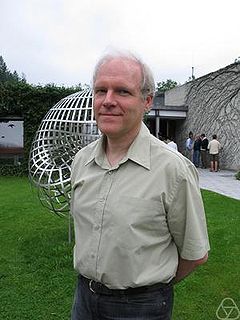Related Research Articles
The Riemann–Roch theorem is an important theorem in mathematics, specifically in complex analysis and algebraic geometry, for the computation of the dimension of the space of meromorphic functions with prescribed zeros and allowed poles. It relates the complex analysis of a connected compact Riemann surface with the surface's purely topological genus g, in a way that can be carried over into purely algebraic settings.

In algebraic geometry, a projective variety over an algebraically closed field k is a subset of some projective n-space over k that is the zero-locus of some finite family of homogeneous polynomials of n + 1 variables with coefficients in k, that generate a prime ideal, the defining ideal of the variety. Equivalently, an algebraic variety is projective if it can be embedded as a Zariski closed subvariety of .
In mathematics, a del Pezzo surface or Fano surface is a two-dimensional Fano variety, in other words a non-singular projective algebraic surface with ample anticanonical divisor class. They are in some sense the opposite of surfaces of general type, whose canonical class is big.
In mathematics, the canonical bundle of a non-singular algebraic variety of dimension over a field is the line bundle , which is the nth exterior power of the cotangent bundle Ω on V.
In mathematics, a distinctive feature of algebraic geometry is that some line bundles on a projective variety can be considered "positive", while others are "negative". The most important notion of positivity is that of an ample line bundle, although there are several related classes of line bundles. Roughly speaking, positivity properties of a line bundle are related to having many global sections. Understanding the ample line bundles on a given variety X amounts to understanding the different ways of mapping X into projective space. In view of the correspondence between line bundles and divisors, there is an equivalent notion of an ample divisor.
In algebraic geometry, divisors are a generalization of codimension-1 subvarieties of algebraic varieties. Two different generalizations are in common use, Cartier divisors and Weil divisors. Both are ultimately derived from the notion of divisibility in the integers and algebraic number fields.
This is a glossary of arithmetic and diophantine geometry in mathematics, areas growing out of the traditional study of Diophantine equations to encompass large parts of number theory and algebraic geometry. Much of the theory is in the form of proposed conjectures, which can be related at various levels of generality.
In algebraic geometry, a line bundle on a projective variety is nef if it has nonnegative degree on every curve in the variety. The classes of nef line bundles are described by a convex cone, and the possible contractions of the variety correspond to certain faces of the nef cone. In view of the correspondence between line bundles and divisors, there is an equivalent notion of a nef divisor.
In number theory, the Néron–Tate height is a quadratic form on the Mordell–Weil group of rational points of an abelian variety defined over a global field. It is named after André Néron and John Tate.
In mathematics, the cone of curves of an algebraic variety is a combinatorial invariant of importance to the birational geometry of .
In mathematics, canonical singularities appear as singularities of the canonical model of a projective variety, and terminal singularities are special cases that appear as singularities of minimal models. They were introduced by Reid (1980). Terminal singularities are important in the minimal model program because smooth minimal models do not always exist, and thus one must allow certain singularities, namely the terminal singularities.
In algebraic geometry, Reider's theorem gives conditions for a line bundle on a projective surface to be very ample.
Projective space plays a central role in algebraic geometry. The aim of this article is to define the notion in terms of abstract algebraic geometry and to describe some basic uses of projective space.
In mathematics, Vojta's conjecture is a conjecture introduced by Paul Vojta (1987) about heights of points on algebraic varieties over number fields. The conjecture was motivated by an analogy between diophantine approximation and Nevanlinna theory in complex analysis. It implies many other conjectures in Diophantine approximation, Diophantine equations, arithmetic geometry, and mathematical logic.
This is a glossary of algebraic geometry.
In mathematics, the Nevanlinna invariant of an ample divisor D on a normal projective variety X is a real number connected with the rate of growth of the number of rational points on the variety with respect to the embedding defined by the divisor. The concept is named after Rolf Nevanlinna.
In algebraic geometry, a Gorenstein scheme is a locally Noetherian scheme whose local rings are all Gorenstein. The canonical line bundle is defined for any Gorenstein scheme over a field, and its properties are much the same as in the special case of smooth schemes.

Jean-Pierre Demailly is a French mathematician working in complex analysis and differential geometry.
In algebraic geometry, a divisorial scheme is a scheme admitting an "ample family" of line bundles, as opposed to an ample line bundle. In particular, a quasi-projective variety is a divisorial scheme and the notion is a generalization of "quasi-projective". It was introduced in as well as in. The term "divisorial" refers to the fact that "the topology of these varieties is determined by their positive divisors." The class of divisorial schemes is quite large: it includes affine schemes, separated regular schemes and subschemes of a divisorial scheme.
References
- Lang, Serge (1997). Survey of Diophantine Geometry. Springer-Verlag. ISBN 3-540-61223-8.